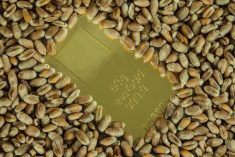Here’s how I know it’s the autumn: I start watching horror movies and feel calmed by the experience. I repeatedly listen to the album Disintegration by the Cure, a depressive album from a depressing year (1989) that also oddly uplifts me.
 And I read dark things and feel cheery afterwards, in a subdued way. I feel a nostalgia-tinged autumnal sadness, and feel the way the turning leaves look.
And I read dark things and feel cheery afterwards, in a subdued way. I feel a nostalgia-tinged autumnal sadness, and feel the way the turning leaves look.
Read Also

Farmer ownership cannot be seen as a guarantee for success
It’s a powerful movement when people band together to form co-ops and credit unions, but member ownership is no guarantee of success.
(Also the calendar says it’s September, the days are growing shorter, and it’s become cold and grey outside – but those are pedestrian ways of telling the season.)
Perfectly timed for this annual period of dreariness is the Canadian Wheat Board’s September PPO Updater, which paints, in the words of analyst Neil Townsend, “a rather ugly picture.” And I found it cheerfully uplifting, but for a reason I’ll only get to at the end of this posting.
Townsend gives a two year outlook and it’s generally bearish. The only supportive factor he sees is the corn stocks situation, and that just limits wheat’s downside. The scenario he plays with has wheat limping through the fall and winter periods propped up by corn. Here are some choice sentences:
“At first glance the conclusion writes itself: corn is tight and bullish and wheat is loose and bearish, 2011-12 will be about shifting demand from corn to wheat . . . “
“There will be no shortage of quality or protein spring wheat inn 2011-12 and the inevitable result will be that spring wheat will have to ‘buy’ market share (back) from hard red winter. That means price differences, in particular offshore prices, between spring and winter wheat will narrow. Given that the world has ample wheat, price decreases from current levels would be precipitous without the tangible support offered by corn.”
The winter doesn’t look any more cheery to Neil:
“South American planting will promise strong gains in corn acreage and keep prices under the gun and there is a good chance that corn will trade towards the six dollar per bushel level. Throw in the usual end of year futures market profit-taking and the result could be a rather dramatic corn price drop. Wheat will fall at least as far in percentage terms and perhaps add on an extra few per cent for the simple fact that world wheat supply and demand is so loose and crops from Australia and Argentina will be hitting the market.. So from today’s levels it is not unlikely that March 2012 corn and Minneapolis wheat futures on Dec. 31 will be $6.25 and $7.50.”
By spring he envisions corn and wheat futures recovering some of the loss as the annual battle for acres takes place. And fall 2012 prices will reflect yields and production in summer 2012. And that’s up to the weather.
But after that all the bearish conditions reassert themselves into a grimmer longer term future.
“The real threat to the price structure is if conditions are favourable in 2013-14 because if the U.S. hits a second consecutive (average) corn crop and average results occur in the rest of the world then September 14, 2013 may very well see five dollar per bushel corn and six dollar per bushel wheat futures.”
This longish term forecast is filled with assumptions and probabilities, and we all know that all sorts of things can conspire to destroy well-thought-out scenarios. But as a reasonable projection of where things are most likely to go, this is about as good as it gets. And it’s dark and dreary, just like the weather outside here in Winnipeg today.
But I found reading this actually a cheering experience, and that’s because it reinforced the point I often forget these days, which is that we’re floating around now atop prices far higher than normal historical levels, and forward prices way out into the future still allow producers to lock-in profits – for now.
And that’s the note Neil ends his piece with:
“Simply put, you cannot fight progress or time and sometimes they conspire to paint a rather ugly picture. Do yourself a solid, commit this moment to memory and relish the fact that prices are so high here and now.”
Amen, brother. But let me add one suggestion to that: think of hedging some way-off-in-the-future production if you think this scenario is at all reasonable. Lots of people are bullish right now. Townsend is obviously bearish. But if there are real downside risks, why not take a tiny amount of them off the table?
Of course, you can’t really do that with CWB grains right now because of the messed up situation about what the heck’s going to happen with the board monopoly come 2012-13, so PPOs aren’t working for now, futures are dangerous until the situation is cleared up, and cash contracts are similarly in limbo.
But for other crops things are possible. So take this dark, grey period of the year to consider the downside to prices, and consider what you can do to minimize it.















